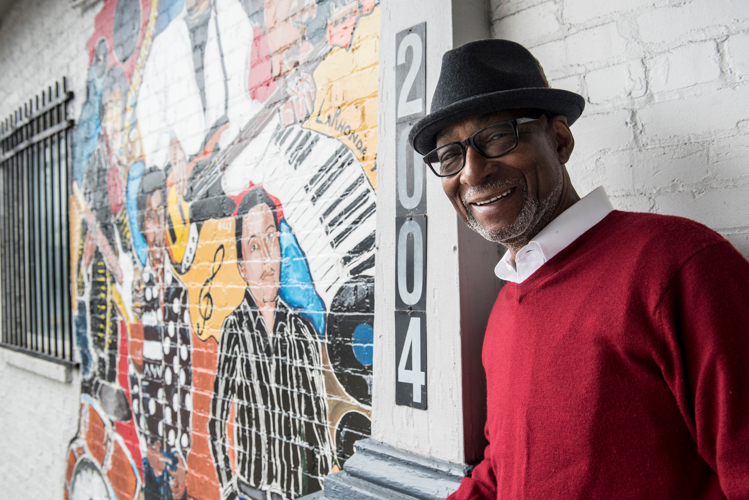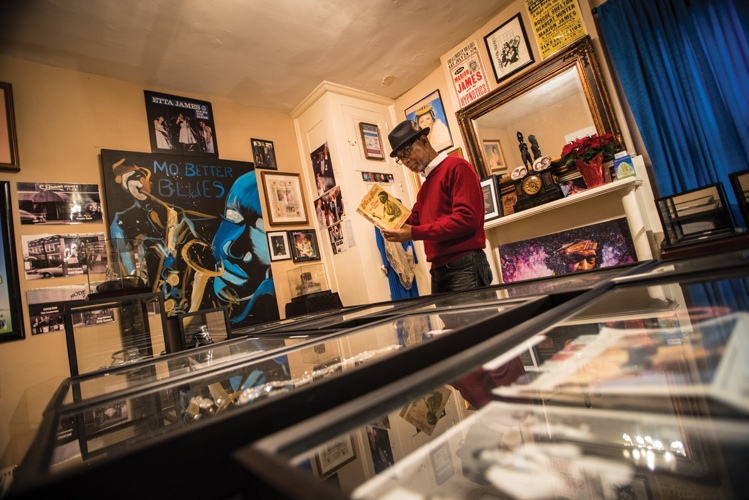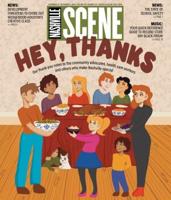
Lorenzo Washington
If you’ve driven down Jefferson Street recently, you may have noticed a new mural. Or maybe you haven’t. Tucked into a small, nondescript white house on the block between Dr. D.B. Todd Jr. Boulevard and the I-40 overpass is Jefferson Street Sound, a recording studio, rehearsal space and “mini museum” dedicated to preserving the history of the Jefferson Street music scene of the mid-20th century. It’s also home to one of the neighborhood’s newest murals, a bright, abstract take on Jimi Hendrix and Billy Cox painted by Nashville visual artist LaRhonda Angelisa and commissioned by Jefferson Street Sound founder and CEO Lorenzo Washington.
“Lorenzo had been asking me if I wanted to do a mural project down here, and I thought it would be a great thing to do for the community,” Angelisa tells the Scene. “To contribute to everything he has going on at Jefferson Street Sound, to preserve the legacy of Jimi Hendrix and Billy Cox, who is the only living member left of Jimi Hendrix’s band. This is a historical part of Nashville, so I think it’s important that we do preserve it.”
“Preservation” is the key word at Jefferson Street Sound. Washington has gone to great lengths documenting the legacy of Music City’s once-bustling hotbed of blues and R&B, and the strip once home to famed clubs like the Del Morocco and Club Baron. Those clubs showcased legends-to-be like Jimi Hendrix, Little Richard, Otis Redding and Marion James in the ’40s, ’50s and ’60s. The venues have long since been shuttered, many due to the construction of Interstate 40 in 1968. The only original building still standing is the site of Club Baron, which now houses Elks Lodge No. 1102.
“What we’re trying to do with the Elks [Lodge] is get it onto the historical register,” Washington explains. “That’s the only building left on Jefferson Street that housed black entertainment, so we’re really trying to save that building. That building is a landmark. That’s where Jimi Hendrix and Johnny Jones had their guitar duel. It was in that building. That’s where Little Richard, when he put out the song ‘Tutti Frutti,’ that’s where he performed, in that building.
“Folks are looking for music over here from over here on Jefferson Street,” Washington continues. “Where’s the music that used to be on Jefferson Street? It was there! All these clubs were there!”
Washington is doing his part to keep that music alive and in its original neighborhood. Upon entering the Jefferson Street Sound building, visitors see memorabilia, art and photographs from floor to ceiling. The entryway boasts an oil painting of James, Nashville’s “Queen of the Blues,” and a number of press clippings about the work Washington has done since Jefferson Street Sound opened its doors in 2013.
The “mini museum” adjacent to Washington’s office area is lined with photos of the preservationist, now in his 70s, posing with friends and supporters. “These are all the people who have left footprints on my life,” Washington says, pointing at the pictures with a smile. The space is small, but it packs a punch. There is an evening gown belonging to James in the corner, a bass strap from Cox in a glass case, a spoon from Lucius “Spoonman” Talley, who’d visited Washington about 15 minutes prior to the Scene’s interview, in another. There are photos of Ironing Board Sam.
“Ironing Board Sam played down at the Del Morocco,” Washington says. “He played downstairs, and Jimi Hendrix, I think, was upstairs.” Little Richard and Clifford Curry, a Knoxville-born R&B/soul singer known for hits like “She Shot a Hole in My Soul” — their pictures line the walls as well.
“[Curry] just passed a few months ago, about two-and-a-half months ago,” Washington says, pointing to a personalized poster given to him by the late musician. “He had written on one of his posters and given it to me. And that’s real cool, that I’ve got that, that he thought that of me.”
Washington’s collection is impressive — it’s a testament not only to his dedication to the Jefferson Street legacy, but to the genuine relationships he’s formed with those involved in those early, under-recognized days of the street’s club scene.
“People give them to me, bring over pictures that were parts of their families, their cousin, their brother, their son was one of these musicians,” Washington says of his artifacts. “Now Marion James, she collected stuff. I got an original picture up there of Marion James.”

Inside Jefferson Street Sound headquarters
Washington has an especially sizable number of items from James, who died of a stroke at age 81 late last year. “That piano was Marion James’ piano,” Washington says, pointing to a piano next to his desk. “That’s the one she wrote all her music on. [Like] her hit single, ‘That’s My Man.’ She was very proud of that.”
Washington and James’ friendship went back many years, and only grew stronger as the iconic blues singer neared the end of her life. “She was in and out of nursing homes and the hospital, and we had become such good friends,” Washington recounts. “I’d take dinner up there every Sunday, and we’d look at the football games together. She came up with this saying — when a football game comes on, you know how a lot of us guys, we’re right there — so she came up with this saying, she said, ‘Lorenzo, I just thought of a song title, or a line: Football ain’t no woman, but it sure can take your man.’ ”
James herself never got a chance to cut that track, but Washington is doing his best to make sure the lyric — which he brings up more than once, with the same mischievous grin each time — sees the light of day. He and longtime friend Thomas Cain, a renowned Nashville songwriter and musician, are setting the lyrics to music, hoping to release a complete track before, as Washington says with a laugh, “those Titans are out of a season.”
While the museum and studio’s downstairs space is all about preserving the past, upstairs is squarely about ensuring the neighborhood continues its musical legacy into the future. Washington hopes the building he describes as once being “a wreck” can serve as “a community haven from back in the day.”
To make that happen, Washington and Cain are working on their project in the building’s upstairs recording studio, which also houses Nashville Christian hip-hop act G.R.I.T.S., a Grammy- and Dove Award-winning duo featuring Stacy “Coffee” Jones and Teron “Bonafide” Carter. The two plan to release an EP, recorded at Jefferson Street Sound, in the coming weeks. Not bad considering how Washington originally leased the once-dilapidated space to house his cleaning business after high rent prices forced him to move from a prior location on Franklin Road. But the neighborhood spoke to his musical past — he owned a record shop called the Soul Shack in the Buena Vista neighborhood of North Nashville in the ’70s — eventually inspiring him to open Jefferson Street Sound.
The building’s new mural is just one of many efforts Washington has underway for creating and maintaining such a haven. It’s as vibrant as the Jefferson Street scene itself once was, and hints at the vibrancy he hopes returns to the neighborhood.
“This is what God wanted to happen in this building,” Washington says. “He wanted the history, and not only the history, but the future of the music, the sound and tones that are going to be part of the future, coming out of here, too. This is the capital of Nashville as far as R&B and blues music. It’s Jefferson Street. I’m not no big nothing. I’m just a regular guy that God blessed with this idea.”
Email music@nashvillescene.com






